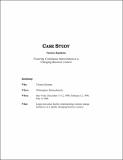| dc.description.abstract | For over five decades, Textron Systems has been an important contributor to the U.S. defense aerospace business. Its breakthroughs in thermal protection materials enabled NASA Apollo command modules and Air Force intercontinental missiles to successfully re-enter the earth’s atmosphere. High strength, lightweight boron composites from Textron Systems help carry the primary structural load in the Space Shuttle orbiter and today’s aircraft carriers rely on Textron’s automated landing systems. Textron highlights smart systems, including smart air and ground munitions, as its unique value add in the 21st Century global marketplace -- products that can rapidly acquire, analyze and act on real-time data inputs. The constant adaptation of its product line and business strategy is a defining feature of Textron Systems as a business. This is a significant accomplishment for the business, but a constant challenge when it comes to work organization and skill development. Textron Systems is based in Wilmington, Massachusetts, with additional facilities in three other locations. This case study is focused on the Wilmington operations. | en_US |
